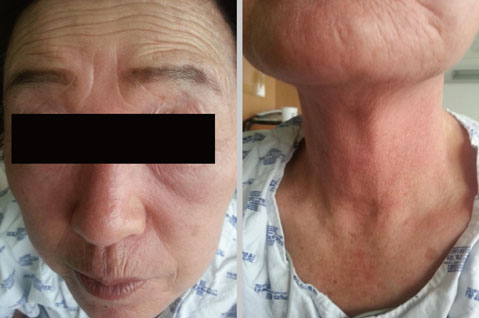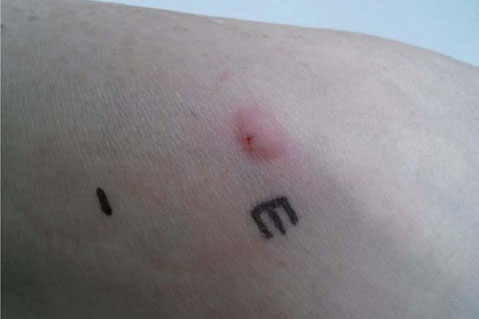Anaphylaxis caused by muscle relaxant (eperisone hydrochloride)
- Affiliations
-
- 1Department of Internal Medicine, Jeju National University School of Medicine, Jeju, Korea. doc4u@hanmail.net
- KMID: 2261867
- DOI: http://doi.org/10.4168/aard.2013.1.2.172
Abstract
- Eperisone hydrochloride is an antispasmodic drug, decreasing spasticity of skeletal muscle and alleviating stiffness, and as a consequence, controlling pain. It is preferably prescribed with other analgesics, beneficially less decreasing alertness compared with other antispasmodics. Its fatal drug adverse reactions were rarely reported. A 70 year-old female with hives, swollen face, hoarse voice, and near fainting admitted via emergency department. She suffered from the series of the fatal symptoms after administration of the pills, prescribed for her neck pain. Two months before, she had experienced hives on similar medications. At presentation, she revealed hypoxemia and hypotension, and treated with epinephrine, glucocorticoids and antihistamines. Among the medicines she took, eperisone hydrochloride was proven as the causative medicine and others were excluded in oral provocation tests. The positive result in intradermal test with eperisone hydrochloride suggested immediate-type hypersensitivity reaction. We report a case of anaphylaxis to eperisone hydrochloride, one of the widely prescribed medicines in clinical practice, previously without awareness of drug adverse reaction.
MeSH Terms
-
Analgesics
Anaphylaxis
Anoxia
Drug Hypersensitivity
Emergencies
Epinephrine
Female
Glucocorticoids
Histamine Antagonists
Humans
Hypersensitivity
Hypersensitivity, Immediate
Hypotension
Intradermal Tests
Muscle Spasticity
Muscle, Skeletal
Muscles
Neck Pain
Parasympatholytics
Propiophenones
Syncope
Urticaria
Voice
Analgesics
Epinephrine
Glucocorticoids
Histamine Antagonists
Parasympatholytics
Propiophenones
Figure
Cited by 3 articles
-
Eperisone-Induced Anaphylaxis: Pharmacovigilance Data and Results of Allergy Testing
Kyung Hee Park, Sang Chul Lee, Ji Eun Yuk, Sung-Ryeol Kim, Jae-Hyun Lee, Jung-Won Park
Allergy Asthma Immunol Res. 2019;11(2):231-240. doi: 10.4168/aair.2019.11.2.231.Overview of anaphylaxis in Korea: diagnosis and management
Gwang Cheon Jang, Yoon-Seok Chang, Sun Hee Choi, Woo-Jung Song, Soo-Young Lee, Hae-Sim Park, Hye-Ryun Kang, Yeong-Min Ye, Hyun-Jung Jin, Mi Yong Shin, Soo-Jin Lee, Hye One Kim, Jihyun Kim, Jae-Woo Jung, Hee-Bom Moon, Youngmin Ahn
Allergy Asthma Respir Dis. 2013;1(3):181-196. doi: 10.4168/aard.2013.1.3.181.A case series of eperisone-induced immediate hypersensitivity
Dong Yoon Kang, Jin Lee, young-Hee Sohn, Sung Yoon Kang, Yoon Sook Cho, Hye-Ryun Kang
Allergy Asthma Respir Dis. 2017;5(4):228-231. doi: 10.4168/aard.2017.5.4.228.
Reference
-
1. Inoue S, Bian K, Okamura T, Okunishi H, Toda N. Mechanisms of action of eperisone on isolated dog saphenous arteries and veins. Jpn J Pharmacol. 1989; 50:271–282.
Article2. Iwase S, Mano T, Saito M, Ishida G. Effect of a centrally-acting muscle relaxant, eperisone hydrochloride, on muscle sympathetic nerve activity in humans. Funct Neurol. 1992; 7:459–470.3. Matsunaga M, Uemura Y, Yonemoto Y, Kanai K, Etoh H, Tanaka S, et al. Long-lasting muscle relaxant activity of eperisone hydrochloride after percutaneous administration in rats. Jpn J Pharmacol. 1997; 73:215–220.
Article4. Ochiai T, Ishida R. Pharmacological studies on 6-amino-2-fluoromethyl-3-(O-tolyl)-4(3H)-quinazolinone (afloqualone), a new centrally acting muscle relaxant. (II) Effects on the spinal reflex potential and the rigidity. Jpn J Pharmacol. 1982; 32:427–438.
Article5. Kim YK. Drug allergy update. J Asthma Allergy Clin Immunol. 2000; 20:855–865.6. Lee AY. Drug allergy update. J Asthma Allergy Clin Immunol. 2002; 22:669–676.7. Brockow K, Romano A, Blanca M, Ring J, Pichler W, Demoly P. General considerations for skin test procedures in the diagnosis of drug hypersensitivity. Allergy. 2002; 57:45–51.
Article8. Suzuki Y, Ra C. Analysis of the mechanism for the development of allergic skin inflammation and the application for its treatment: aspirin modulation of IgE-dependent mast cell activation: role of aspirin-induced exacerbation of immediate allergy. J Pharmacol Sci. 2009; 110:237–244.
Article9. Choonhakarn C. Non-pigmenting fixed drug eruption: a new case due to eperisone hydrochloride. Br J Dermatol. 2001; 144:1288–1289.
Article10. Ueno T, Kawana S. A case of eperisone hydrochloride (myonal): induced drug eruption leading to erythema and angioedema. Arerugi. 2007; 56:709–713.11. Demitsu T, Tomita Y. Fixed drug eruption due to afloqualone: the first reported case. J Dermatol. 1998; 25:136.
Article12. Ribi C, Vermeulen C, Hauser C. Anaphylactic reactions to tolperisone (Mydocalm). Swiss Med Wkly. 2003; 133:369–371.13. Hur GY, Hwang EK, Moon JY, Ye YM, Shim JJ, Park HS, et al. Oral muscle relaxant may induce immediate allergic reactions. Yonsei Med J. 2012; 53:863–865.
Article14. Cho YJ. Update on the diagnosis of drug allergy. Korean J Med. 2009; 76:282–290.15. Reshef A, Kagey-Sobotka A, Adkinson NF Jr, Lichtenstein LM, Norman PS. The pattern and kinetics in human skin of erythema and mediators during the acute and late-phase response (LPR). J Allergy Clin Immunol. 1989; 84(5 Pt 1):678–687.
Article16. Makabe-Kobayashi Y, Hori Y, Adachi T, Ishigaki-Suzuki S, Kikuchi Y, Kagaya Y, et al. The control effect of histamine on body temperature and respiratory function in IgE-dependent systemic anaphylaxis. J Allergy Clin Immunol. 2002; 110:298–303.
Article
- Full Text Links
- Actions
-
Cited
- CITED
-
- Close
- Share
- Similar articles
-
- Characteristics of Adverse Drug Reactions of Central Muscle Relaxants Including Eperisone: Analysis of KAERS Data
- A case series of eperisone-induced immediate hypersensitivity
- Oral Muscle Relaxant May Induce Immediate Allergic Reactions
- Eperisone-Induced Anaphylaxis: Pharmacovigilance Data and Results of Allergy Testing
- The Clinical Evaluation Of Eperisone Hydrochloride (Mulex)



